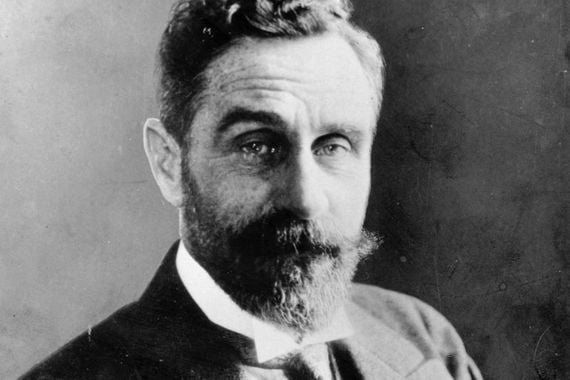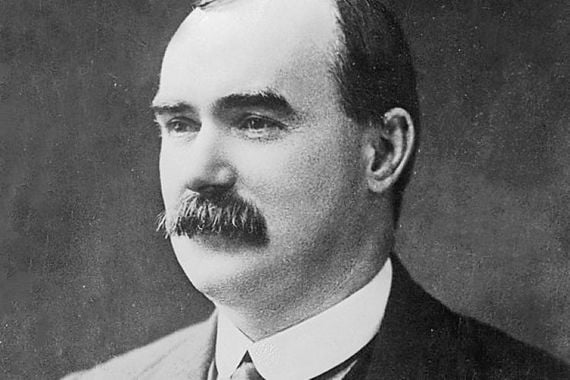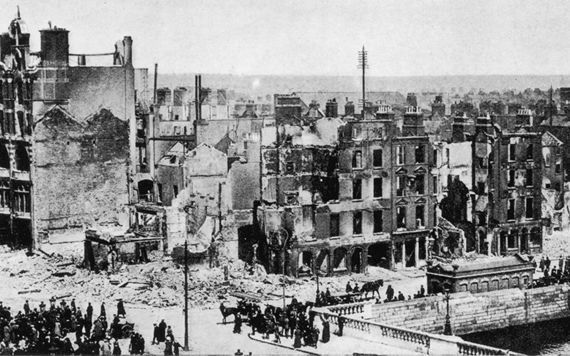Irish America waited on tenterhooks for news from Ireland and the 1916 Easter Rising so much so that in the midst of World War One it was front-page news on the New York Times for two weeks.
After the Easter Rising began on April 24, 1916, Irish America waited, rapt, for news from Dublin.
In fact, the Easter Rising so captured the attention of the entire US that, in the midst of WWI, it occupied the front page of the New York Times 14 days in a row.
Reading the articles offers a fascinating look into how news of (and misinformation about) the Rising spread across the Atlantic in the days and weeks that followed.
Coverage began on April 25, with the news that, four days earlier, Sir Roger Casement had been captured by the British after attempting to bring German ammunition into Ireland, and the German vessel carrying the arms was sunk.
“The news of the capture of Sir Roger was received here with satisfaction, mingled with regret, at the close of what, previous to his alleged activities with the Germans, had been a brilliant career, useful both to humanity and his own country, That he should have engaged in such a madcap enterprise as the official communication gives as the reason for his seizure is thought to lend color to the view held by old friends here that he is mentally unbalanced,” the article read – an interesting take given the smear campaign the British would start in order to quell protests over his execution.
There was no mention, however, of the rebellion that had started the day before with the seizure of the General Post Office in Dublin. The Times began reporting on the Rising itself on April 26, with the headline “TROOPS CRUSH REVOLT IN DUBLIN; TAKE POST OFFICE SEIZED BY RIOTERS; MANY KILLED IN STREET FIGHTING.”
“Almost coincidental with the capture of Sir Roger Casement, leader of the Separatist Faction in Ireland, while he was attempting to land arms from Germany on the coast of Ireland, there has occurred in Ireland a revolutionary outbreak of considerable proportions,” the article begins.

Roger Casement
Relying almost exclusively on British government accounts of the rebellion, it goes on to state that members of the Sinn Féin Society had taken over the General Post Office (GPO), St. Stephen’s Green, and a number of homes in Dublin, but that “military authorities had the situation well in hand.”
News the following day concerned the instating of martial law in Dublin City and County, and further information about the rebellion and the earlier arrest of Roger Casement, again relying mainly on information from official British channels. It does, however, note that one of the questions posed to Augustine Birrell, Chief Secretary for Ireland, concerning censorship in Ireland:
“Mr. Birrell said it had been thought necessary during the last few days that news should not reach neutral countries, especially ‘our friends in America,’ which would be calculated to give a false impression of the importance of the events, important as they were.”
Irish American perspective came into play on April 28, with an article about the claims made by John Devoy, the exiled Irish rebel and editor of the Gaelic American newspaper, that the administration of President Woodrow Wilson had tipped off the British Army regarding the German ship en route to Ireland with ammunition. This was vehemently denied by then-Secretary of State Robert Lansing (the US, at the time, was still neutral).
Read more
It was also reported on that day that all of Ireland was under martial law and that the British forces, led by Major General John Maxwell, had not yet resumed control of Dublin. The city, in the midst of rebellion, was still entirely cut off from the rest of the world.
“Dublin is further from London today than Peking is from New York, so far as communication is concerned," a wire service dispatch published by The Times on April 28 read. "No Irish newspapers have reached here since the rising, and passenger traffic has been for the most part suspended. The only information comes through official channels."
On the 29th, the day the rebels surrendered, the Times ran a more thorough description of the realities in Dublin during the Rising, based on the accounts of people who had fled Ireland for London. They included a summary of the buildings and areas taken over by the rebels, and the rumor that a woman “stated to be of a high title” (Countess Markievicz) was a Sinn Féin leader.
One witness, an English woman who was holidaying in Dublin, recounted the general civilian reaction to the rebels as “interested and amused” and the public attitude as “one more of tolerant interest, even amusement, in the doings of the Sinn Feiners rather than any apprehension of the lawless acts which were being perpetrated in every direction.”
The paper also carried despairing remarks from John Redmond, the Irish Parliamentary Party leader, and Home Rule advocate, arguing that the rebellion would set Ireland far back in its course towards independence. Meanwhile, at a meeting of the New York Council of the United Irish League of America, a group of Irish and Germans protested against John Redmond, the Allies, and the arrest of Roger Casement.
James Connolly, the Scottish-born Irish Republican and Socialist leader who was one of the key leaders of the Rising, was incorrectly reported as killed on April 30. The first mention of the Proclamation of the Irish Republic, signed by Connolly and the six other main leaders of the Rising, also came on the 30th.

James Connolly.
An in-depth article from that day also delved into the Irish American perspective on the Rising, stating “Irish separatists in this country do not believe that the uprising in Dublin was the formal planned beginning of a revolution … But they do believe that Ireland’s golden opportunity for revolution has come and that the Dublin incident … will serve very well for the historian of a Free Ireland as a picturesque point of departure — in short, another Boston Tea Party or Battle of Lexington.”
Indeed, an additional report on the Irish American reaction on May 1 showed many to be in favor of the rebellion, and highlighted the Irish-German connection with a mouthful of a first paragraph: “The George M. Cohan Theatre was crowded to the doors last night with Irishmen, Irish women, and Germans, who had gathered there in the name of the United Irish Societies of America to voice their approval of the present uprising in Ireland, to sing songs of Germany as well as of Ireland, to denounce John Redmond as a traitor, to cheer a reference to the sinking of the 'munition ship Lusitania,' to pass a resolution urging the recognition of the belligerency of Ireland and the linking of the Teutonic powers as a military ally, and to compare Sir Roger Casement to George Washington.”
A statement from John Redmond appeared on the same day, announcing the end of the Rising and denouncing its participants: “As to the opinion of the Irish race, I have received communications from all parts of the world declaring vehement condemnation by Irishmen of this insane and wicked attempt to destroy all Ireland’s hope just at the moment when, after centuries of vain struggle, they were about to be fully realized.
"I beg our people in America not to be unduly disturbed by this futile and miserable attempt to destroy Ireland. It has failed - definitely, finally failed.”
Read more
Continued fighting by smaller pockets of rebels was also reported, despite the surrender of the Rising leaders. The headline the following day read “DUBLIN REBELS ALL PRISONERS AND THE CITY QUIET.”
At times, vague news of the rebel executions occupied the front pages as the days continued, and the reports also offered some insight into life in Dublin in the wake of the Rising.
“An army officer said today that he had been stationed in Dublin for many months and that he always had been the subject of disrespect from the lower elements of the population. Today, however, a passerby accidentally jostled him and at once apologized, much to his astonishment."
There was also this on May 6: “The effect of martial law on the sobriety of the Dublin populace is very marked. Saloons are allowed to open only between 2 and 5 o’clock in the afternoon, and, in consequence, drunkenness has become rare if it has not entirely disappeared. In the evening at the approach of 7:30, when all civilians bust be indoors, there is a general scamper to reach home, for no one is allowed to pass without a challenge.”
The execution to receive the most attention was that of Joseph Plunkett, mostly because of his marriage only hours earlier to his fiancée Grace Gifford. Her sister, Muriel, was the wife of Rising leader Thomas MacDonagh, who was also executed.
Though the May 7 article went into great detail, it was decidedly unsympathetic, describing the sisters’ story as one of “a well-known and honored Dublin family brought to sorrow and tribulation by the crime of Sinn Féin, and of two refined, artistic girls, well known in Dublin society, whose lives have been wrecked by the insane folly of two men.”
Irish coverage left the front page on May 9: the news that four more leaders of the Rising had been executed appeared on page 8. It was back again on May 10, 12, 13, 14, 15, 16, and 17th as Roger Casement’s trial progressed in London and continued on May 18, 19, 20, and 21 as the fate of Jeremiah C. Lynch, a naturalized American citizen who participated in the Rising, hung in the balance. Lynch had been sentenced to execution, but his life was spared following intervention from the US State Department.
*Originally published during the 1916 centenary in 2016. Updated in April 2023.

Love Irish history? Share your favorite stories with other history buffs in the IrishCentral History Facebook group.




Comments